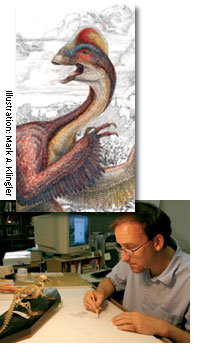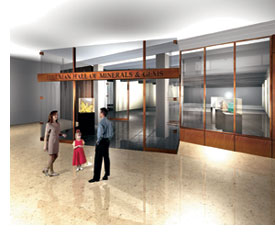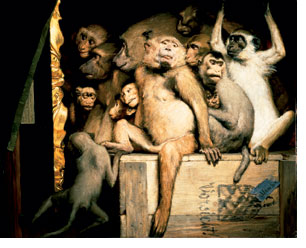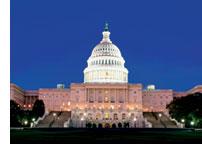Back
A one-man show of fur, feathers, and
fossils.
 As
visitors walk through Carnegie Museum of Natural History’s
fossil exhibits, they’re treated to intricate illustrations
of creatures that lived long before there were humans around
to sketch them. The man responsible for these real-life
recreations is Mark Klingler, master scientific illustrator
for the museum. The cumulative excellence of Klingler’s
work is now on display in a solo exhibition called Fur,
Feathers and Fossils at the William T. Golden Center for
Science and Engineering in Washington, D.C. As
visitors walk through Carnegie Museum of Natural History’s
fossil exhibits, they’re treated to intricate illustrations
of creatures that lived long before there were humans around
to sketch them. The man responsible for these real-life
recreations is Mark Klingler, master scientific illustrator
for the museum. The cumulative excellence of Klingler’s
work is now on display in a solo exhibition called Fur,
Feathers and Fossils at the William T. Golden Center for
Science and Engineering in Washington, D.C.
The invitation
for the solo show came from the American Association for
the Advancement of Science (AAAS). The
AAAS publishes the internationally recognized Science magazine,
for which Klingler provided the cover art for a May 2001
issue featuring a published paper by Carnegie Museum scientist
Dr. Zhe-Xi Luo on the earliest mammal ever discovered,
the Hadrocodium wui (which had the appearance of a large
mouse). Klingler would go on to win an award for the illu-stration
from the Society of Vertebrate Paelontology. In addition
to Science, Klingler’s scientific illustrations have
also appeared in National Geographic, Discover, and Nature.
“
While I’ve exhibited my work before, this is by far
my largest solo exhibition,” Klingler says. And how
did it feel to see 100 pieces of his work—from reconstructions
of fossil organisms to wildlife illustrations—on
display in the nation’s capitol? “Fantastic!” he
says.
The exhibit in Washington, D.C.,
runs through March 2006 before returning to Klingler’s
home base in Pittsburgh for an exhibit at Carnegie Museum
of Natural History that
opens June 10, 2006.
Making room for more beautiful gems.
 A
special occasion was made even more so for the 170 people
attending the Hillman Hall of Minerals and Gems’ 25th
anniversary celebration when Carnegie Museum of Natural
History announced plans to expand the
hall, highlighted by a gallery dedicated to gems and jewelry. A
special occasion was made even more so for the 170 people
attending the Hillman Hall of Minerals and Gems’ 25th
anniversary celebration when Carnegie Museum of Natural
History announced plans to expand the
hall, highlighted by a gallery dedicated to gems and jewelry.
But it became downright unforgettable for one guest in
particular when Henry Hillman revealed the name of one
part of the expansion—The Ronald W. Wertz Gallery,
in honor of a man he says has worked with the museum to
develop “one of the most active and successful mineral
and gem acquisition programs of any major natural history
museum in North America.”
“
I thank Henry and Carnegie Museum for this unexpected honor,” Wertz
said, reacting to the news. “We had always hoped
to have the opportunity to expand the hall, and the Wertz
Gallery will meet that need.”
The Hillman Hall of
Minerals and Gems is considered among the top exhibits
of its kind, with more than 1,300 minerals
and gems from around the world. The expansion project will
enable it “to place more of an emphasis on exhibiting
gems and jewelry," noted Bill DeWalt, director of
Carnegie Museum of Natural History. Hillman Hall’s expansion plans also include a dynamic new entryway and
space for traveling exhibits.
A million-dollar
difference.
The
difference is measurable® isn’t just Mellon
Financial Corporation’s corporate mantra. It also
describes the company’s
impact on the local community. Take, for instance, Mellon’s
recent million-dollar commitment to the future of Carnegie
Museums of Pittsburgh and the region. And add that to the
$1.5 million Mellon has contributed to the museums over
the past 15 years.
It’s money that Mellon’s
Chairman and Chief Executive Officer Marty McGuinn considers “an
investment in the future of the whole city.” In his
words, “The
four Carnegie Museums provide so many diverse opportunities
for people from all walks of life. We believe the museums
are a critical component to the ongoing economic development
of western Pennsylvania. Supporting them makes good business
sense.”
You can measure the difference Mellon has
made for Carnegie Museums by its funding of The Andy Warhol
Museum’s
opening event in 1994; its endowment to support The
Warhol’s
Mellon Bank Education Resource Center; its funding
of various programs at Carnegie Science Center; its decision
to be
lead sponsor of the 1999-2000 Carnegie International; and
the company’s sponsorship of Carnegie Museum of Natural
History’s spectacular 2004 DinoMite Days Gala.
“
Thanks to its latest million-dollar gift,” says Carnegie
Museums of Pittsburgh President David Hillenbrand, “the
difference that Mellon makes to Carnegie Museums, and the
region, will be felt for years to come.”
It’s a hit: the evolution of animals on canvas.
 Gabriel
Max, The Jury of Apes, 1889, Oil on canvas, Bayerische Staatsgemaldesammlungen,
Neue Pinakothek, Munich Gabriel
Max, The Jury of Apes, 1889, Oil on canvas, Bayerische Staatsgemaldesammlungen,
Neue Pinakothek, Munich
It
took the Industrial Revolution, the discovery of dinosaur fossils, and
Darwin's theory of evolution to make people start thinking of animals as
more than
just things to put on a plate or in front of a plow. Fierce Friends, Artists
and Animals, 1750-1900, a collaboration between curators at Carnegie
Museum of Art and Amsterdam’s Van Gogh Museum, captures how all this
new information affected the artists of the time. Recently opening at the
Van Gogh Museum
to great reviews, Fierce Friends was organized by Louise Lippincott,
curator of fine arts at Carnegie Museum of Art, and Andreas Blühm
from the Van Gogh. Noted international art critic Richard Dorment, in a
London Telegraph article praising the show, called the duo “the most interesting art
historians working anywhere in the world today.”
The exhibition traces
the evolution of animal art from anatomically incorrect images to paintings
infused with human-like feelings and emotions. Highlights include the first
underwater
landscape, a painting of a monkey, a painting by a monkey, and two works
by Van Gogh: a crab struggling helplessly on its back and a haunting
image
of a bat, orange light glowing from behind its transparent wings.
The
exhibition comes to Carnegie Museum of Art in March 2006 and is the kickoff
event for Pittsburgh Roars, a nine-month regional marketing campaign
promoting
western Pennsylvania as a must-see cultural destination.
Andy Warhol goes to Washington.
 Prolific
and provocative, iconic and iconoclastic, Andy Warhol challenged
a lot of traditional notions about art and culture. And
now he’s challenging the notion that Pittsburgh can’t
show people in larger cities something about, well, art
and culture. Prolific
and provocative, iconic and iconoclastic, Andy Warhol challenged
a lot of traditional notions about art and culture. And
now he’s challenging the notion that Pittsburgh can’t
show people in larger cities something about, well, art
and culture.
The Andy Warhol Museum has collaborated with
the Corcoran Gallery of Art in Washington, D.C., to present
Warhol Legacy:
Selections from The Andy Warhol Museum, an exhibition
of more than 150 of Warhol’s paintings, photographs,
drawings, sculptures, works on paper, and films. The exhibition,
which opened in September and runs
through February 20, is being sponsored by PNC Bank Financial
Services Group.
“
Most of us are very familiar with Warhol’s famous
images of Campbell’s Soup cans, Marilyn Monroe, and
the like, many of which are part of this exhibition,” says
Stacey Schmidt, associate curator of contemporary art at
the Corcoran. “But Warhol Legacy offers Corcoran
visitors a chance to discover aspects of Warhol’s
career with which they may not be familiar.”
Those sentiments are echoed by Thomas
Sokolowski, director of The Warhol, who says the Corcoran
exhibition will “help
deepen knowledge of this world-famous artist by incorporating
The Warhol’s unique archival collection.” Better
yet, he notes, “it proves there is still more to
be learned about ‘the boy from Pittsburgh who made
good.’”
A happening place for science.

Science
happens everywhere, every day. But it’s never as
fun or engaging as it is at Carnegie Science Center. That’s
the message of the Science Center’s new promotional
campaign and website. Launched on November 15, the website
allows
visitors to purchase OMNIMAX® tickets online, shop
the XPLOR store, schedule group visits, and get the latest
scientific happenings on the North Shore. Check out
the new website at www.CarnegieScienceCenter.org or www.ScienceHappens.org
Back
| Top |